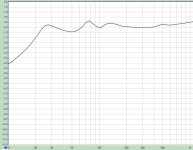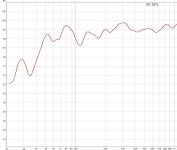You won't get anything meaningful in the sense that at low frequency the dominant factor is ALWAYS room acoustics and so even if you have a peak in frequency response due to the low damping factor this will very likely disappear in the jungle of room modes. This is especially true for low Rp tubes like the 300B where the damping factor is 3-4 and so the peak is quite modest, unless the speaker is awful and totally inadequate for a zero feedback triode amplifier.
Anyway the best way to do that is measuring the Zout of the amplifier as function of frequency. At least you will only make approximations when simulating the speaker load.
Anyway the best way to do that is measuring the Zout of the amplifier as function of frequency. At least you will only make approximations when simulating the speaker load.
The scope of my simulation is to simulate the electrical behaviour of the output stage when driving a loudspeaker driver. Room acoustics is outside of scope when designing an amplifier.
Measuring Zout would be definitely a good way to get the real time behavior of the machine, but I don't have the amplifier in my hands yet. If I had the amplifier alredy in my hands, there would be no benefit from doing a simulation.
I guess some older folks in this group don't understand that the goal of simulations is to estimate the behaviour of a system before building the system.
Once you have the system in your hands, real life measurements are used to confirm if the estimate were accurate or not.
Things have changed from back in the 70s, we have easily available computer nowadays 🙂
Measuring Zout would be definitely a good way to get the real time behavior of the machine, but I don't have the amplifier in my hands yet. If I had the amplifier alredy in my hands, there would be no benefit from doing a simulation.
I guess some older folks in this group don't understand that the goal of simulations is to estimate the behaviour of a system before building the system.
Once you have the system in your hands, real life measurements are used to confirm if the estimate were accurate or not.
Things have changed from back in the 70s, we have easily available computer nowadays 🙂
Not really, however, a demonstration of clearing out potential electrical discrepancies, before proceeding to acoustical measurements already has a good educational value.
I'm a great friend of simulation ... but ...
What does such a comparison add to LF behaviour?


The first is the former full range speaker impedance simulation (based on T/S parameters, generator is ideal).
Second is 800R impedance generator- SX-11 sim - this speaker impedance simulation on OPT output.
BTW if you simulated its with SQ (or with full FR sweep), AND transformer HF parasitic parameters, the discrepancy will be obvious.
What does such a comparison add to LF behaviour?


The first is the former full range speaker impedance simulation (based on T/S parameters, generator is ideal).
Second is 800R impedance generator- SX-11 sim - this speaker impedance simulation on OPT output.
BTW if you simulated its with SQ (or with full FR sweep), AND transformer HF parasitic parameters, the discrepancy will be obvious.
Is there any correlation between these pictures?
View attachment 1267959
View attachment 1267960
The first is real measuring of 300B output (5k:8 OPT, 1W) voltage, loading with real (full range driver, no crossover) loudspeaker.
The other is this loudspeaker's sound pressure (from 1m, in the listening room).
@euro21
Correlation migh not be so obvious, but there is correlation. The sounds pressure is a result of: electrical signal x driver response x room response.
On the other side, if you say "why do I care about -1 dB from the amplifier at 10Hz if my room introduces -30dB attenuation at that frequency?" ..that's a fair argument.
If you look a some reviews of tube amps in Stereophile, there are measurements with speaker load simulations. Like this: https://www.stereophile.com/content/air-tight-atm-300r-power-amplifier-measurementsMeasuring Zout would be definitely a good way to get the real time behavior of the machine, but I don't have the amplifier in my hands yet. If I had the amplifier alredy in my hands, there would be no benefit from doing a simulation.
The simulated typical 2-way speaker (quite bad for a SE tube amp but typical in the commercial sense) results in a deviation from flat response of less than 1 db across the entire audio range which is way better than any loudspeaker can do in real room even with a solid state amp.
You are wasting your time in my opinion but of course you are free to do what you like.
Last edited:
- Home
- Amplifiers
- Tubes / Valves
- Simulate OPT SX-11 at low frequency

